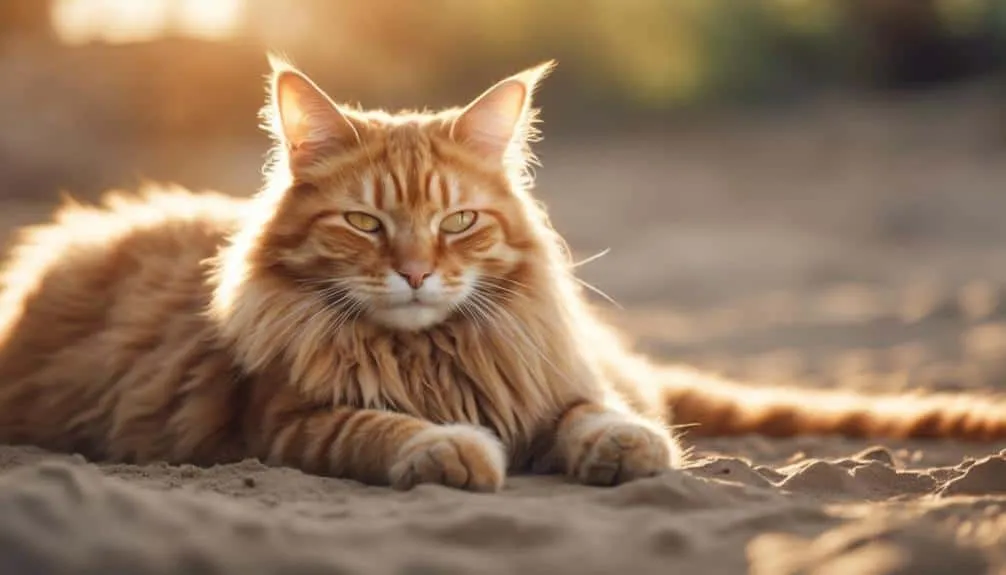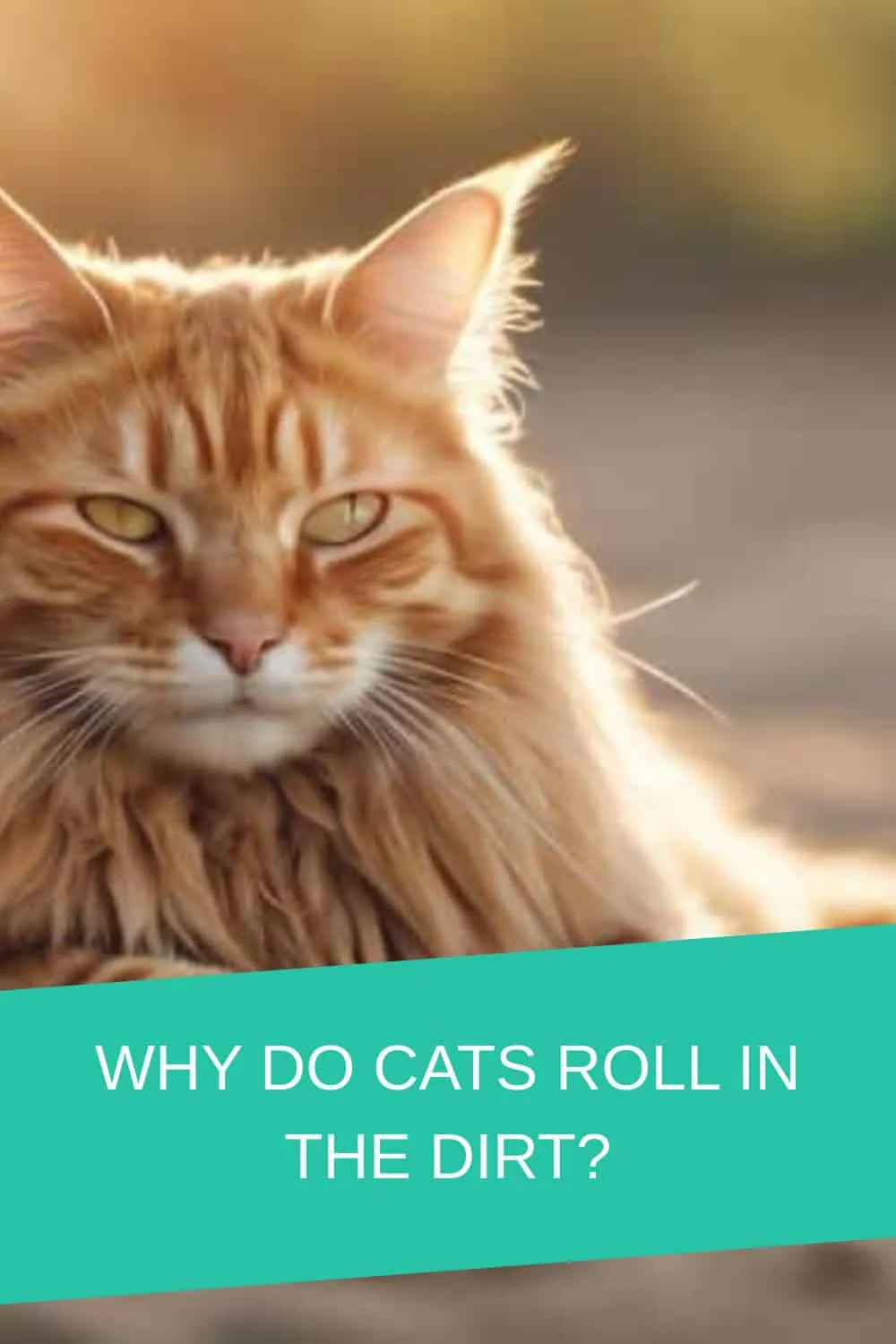The Best Fluffy Pancakes recipe you will fall in love with. Full of tips and tricks to help you make the best pancakes.

Imagine a cat's sleek fur glistening in the sunlight as it gracefully rolls in the dirt, a seemingly puzzling behavior that captivates both cat owners and enthusiasts alike. Curious about what drives your feline friend to indulge in this seemingly peculiar habit? Uncover the hidden motivations behind why cats choose to embrace the earthy embrace of dirt and discover the fascinating insights that shed light on their mysterious behavior.
Key Takeaways
- Regulates body temperature and removes excess oils and dirt from fur.
- Camouflages scent for hunting and survival tactics.
- Serves grooming needs and territorial marking.
- Communicates territory, identity, and status through scent.
- Enhances social communication and supports natural instincts.
Cat's Instinctual Behavior
When cats roll in the dirt, it's often a display of their innate instinctual behavior to maintain their fur and scent. These actions stem from their natural instincts and survival tactics.
Cats are meticulous groomers, and rolling in the dirt helps them regulate their body temperature by removing excess oils and dirt from their fur. This behavior also serves as a way for cats to camouflage their scent, making it easier for them to hunt without being detected by prey or predators.
Sense of Territory
Cats' rolling behavior in the dirt not only serves their grooming needs but also plays a significant role in marking their sense of territory. When cats roll in the dirt, they're engaging in territorial marking behavior. By rubbing their scent onto the ground, they're effectively claiming that area as their own. This instinctual behavior helps them establish boundaries and communicate their presence to other cats in the vicinity.
Understanding this aspect of cat behavior is essential for providing proper environmental enrichment. Cats have a strong need for territory and by allowing them access to safe outdoor spaces or providing indoor environments with scratching posts, climbing structures, and hiding spots, you can help fulfill their natural instincts. Creating a space where they can engage in territorial behaviors like rolling in the dirt can contribute to their overall well-being and contentment.
Social Communication
Social communication in cats involves a variety of vocalizations, body language, and scent marking to convey messages to other felines and even humans. Cats have a significant system of communication that includes meowing, purring, hissing, and growling as vocal cues. Each of these sounds serves a different purpose, such as meowing to get attention or purring to show contentment.
Additionally, body language plays an essential role in cat communication. For example, an arched back and puffed-up fur can signal fear or aggression, while a relaxed posture indicates comfort and trust. Cats also use scent marking through rubbing their bodies against objects or spraying urine to establish territory boundaries and communicate with other cats.
Understanding these forms of communication can help you decipher your cat's feelings and intentions, strengthening your bond and improving your interactions with them.
Grooming and Self-Care
Understanding the significance of grooming and self-care is essential for maintaining your cat's health and well-being. Regular grooming not only helps in coat maintenance but also contributes to your cat's overall relaxation. Brushing your cat's fur helps prevent matting, reduces shedding, and promotes healthy skin. Additionally, grooming sessions provide an excellent opportunity to bond with your feline friend.
Self-care goes beyond grooming; it involves providing environmental enrichment and mental stimulation for your cat. Offering interactive toys, scratching posts, and climbing structures can keep your cat physically and mentally engaged. Cats are natural hunters, so activities like puzzle feeders or hiding treats around the house can satisfy their instincts and provide mental stimulation.
Scent Marking
To understand why cats engage in scent marking behaviors, it's important to recognize the innate territorial instincts that drive this behavior. Cats have specialized scent glands located on their cheeks, paws, and tails which they use to leave pheromone markers in their environment. Through marking behavior, cats communicate information about their territory, identity, and reproductive status to other cats. When a cat rolls in the dirt, it isn't only a fundamental instinct but also a strategic way to distribute their scent over a larger area.
Scent marking is a crucial aspect of feline communication and social interaction. By leaving their scent on various surfaces, cats establish boundaries, claim ownership, and navigate their surroundings. This behavior helps reduce conflicts with other cats by providing clear signals about their presence and status. Understanding the significance of scent marking can help cat owners create a harmonious environment for their feline companions and support their natural instincts.
Stress Relief
When your feline friend is feeling stressed, they might seek solace in rolling around in the dirt. This seemingly peculiar behavior can actually be a form of natural therapy for cats.
Dirt as Cat Therapy
Cat therapists often recommend allowing your feline friend to roll in the dirt as a natural stress-relief technique. Here's why dirt can be therapeutic for your cat:
- Sensory Stimulation: Rolling in dirt provides a range of textures and scents that engage your cat's senses, promoting relaxation.
- Grounding Effect: The earthy feel of dirt beneath their paws can help cats feel grounded and connected to nature, reducing anxiety.
- Natural Cooling: Dirt can absorb excess body heat, offering a cooling sensation that helps cats regulate their temperature during stressful moments.
- Soothing Scratching: Cats enjoy scratching in the dirt, which can be a calming and instinctual behavior that releases tension.
Embracing your cat's natural instincts for outdoor exploration in the form of dirt rolling can be a simple yet effective way to support their well-being.
Natural Behavior Explanation
Curiously, have you ever wondered why cats exhibit the natural behavior of rolling in dirt as a means of stress relief? Animal psychology suggests that this behavior can be attributed to environmental factors impacting feline instincts.
Cats have a keen sense of their surroundings and are highly sensitive to changes in their environment. When stressed, they may seek out natural elements like dirt to engage in behaviors that provide comfort and relief.
Rolling in dirt allows cats to release built-up tension and anxiety, similar to how humans might engage in stress-relieving activities. Understanding these natural behaviors through the lens of animal psychology can help cat owners create environments that promote their feline companions' well-being and mental health.
Cool Down Mechanism
Rolling in the dirt serves as an effective cooling mechanism for cats in hot weather, aiding in temperature regulation by promoting heat dissipation through the evaporation of moisture on their fur. This natural instinct helps cats maintain a comfortable body temperature. Here's why it works:
- Heat Dissipation: The damp soil absorbs excess body heat from the cat's fur, which then evaporates, cooling down the cat in the process.
- Evaporation: As the moisture on the cat's fur evaporates, it creates a cooling effect similar to sweating in humans.
- Insulation: The layer of dirt can act as insulation, preventing the sun's direct heat from reaching the cat's skin.
- Behavioral Response: Cats instinctively seek out cooler areas when they feel hot, and rolling in dirt provides a quick and accessible way to cool down.
Understanding this feline cooling method sheds light on how cats adapt to their environment and regulate their body temperature efficiently.
Pest Control Strategy
To effectively manage potential pests, cats utilize a strategic grooming routine that serves as a vital pest control strategy in their environment. This behavior is deeply rooted in their natural instincts and is considered a behavioral adaptation that aids in their survival.
Cats are meticulous groomers, often spending a significant amount of time licking their fur to keep it clean and free of any parasites or insects that may be present. The rough texture of their tongues helps to remove debris and pests effectively. Additionally, cats' saliva contains enzymes that have antibacterial properties, further assisting in pest control.
Vitamin D Absorption
Cats efficiently absorb vitamin D through exposure to sunlight, an essential process for maintaining their overall health and well-being. Sun exposure plays an important role in ensuring that cats receive an adequate amount of vitamin D, which is essential for various bodily functions.
Here are some key points to help you understand the significance of sunlight exposure for your feline friend:
- Natural Source: Sunlight is a natural and effective way for cats to obtain vitamin D, promoting overall health and vitality.
- Skin Absorption: When cats bask in the sun, their skin absorbs ultraviolet B (UVB) rays, which trigger the synthesis of vitamin D in their bodies.
- Immune System Support: Adequate vitamin D levels contribute to a strong immune system, helping cats fight off infections and diseases.
- Bone Health: Vitamin D aids in calcium absorption, supporting healthy bone development and strength in cats.
Ensuring that your cat receives sufficient sunlight exposure can have numerous health benefits, making it an essential aspect of their care routine.
Entertainment and Play
To ensure your cat stays engaged and mentally stimulated, providing sufficient entertainment and play opportunities is crucial to their overall wellbeing and happiness. Cats thrive on playful antics and funny moments, which can be nurtured through interactive toys and enrichment activities.
Interactive toys, such as feather wands or puzzle feeders, engage your cat's natural instincts and provide mental stimulation. These toys encourage your cat to pounce, chase, and problem-solve, keeping them entertained and active. Enrichment activities like hiding treats around the house or setting up obstacle courses help keep your cat's mind sharp and provide a source of excitement.
Creating a stimulating environment for your cat not only prevents boredom but also strengthens your bond with them. Spend quality time engaging in play sessions, rotating toys regularly to keep things interesting. Observing your cat's playful nature and funny moments can be incredibly rewarding for both you and your feline companion. Remember, a happy and entertained cat is a healthy cat.
Frequently Asked Questions
Can Cats Get Sunburned From Rolling in the Dirt?
When cats roll in the dirt, it could potentially provide some natural sunscreen-like protection against sunburn. However, to guarantee proper skin protection, it's best to use vet-approved sunblock if your feline friend enjoys sunbathing.
Do Cats Roll in the Dirt to Camouflage Their Scent?
Just like a hidden treasure, cats' innate evolutionary behavior of rolling in dirt serves as a natural camouflage to mask their scent. This ritual not only taps into their grooming habits but also links them to their wild ancestry.
Is Rolling in the Dirt a Sign of Illness in Cats?
Rolling in the dirt can indicate various behavioral habits or skin irritations in cats. It may be a sign of illness if excessive or paired with other symptoms. Observing your cat's overall behavior and consulting a vet is essential.
Can Rolling in the Dirt Help Cats Improve Their Mood?
Rolling in the dirt can indeed boost your cat's mood. This behavior stems from their natural instincts and provides mental health benefits. It's a form of environmental enrichment that helps cats feel more relaxed and content.
Do Cats Roll in the Dirt to Mark Their Territory With Scent?
Cats roll in the dirt not just for grooming habits but also to mark their territory with scent. This behavior is a natural part of their outdoor exploration, allowing them to leave their unique signature around their environment.
Conclusion
You've now learned about the various reasons why cats roll in the dirt, from regulating body temperature to social communication.
But did you know that some experts believe that cats also roll in dirt to help repel insects?
The dirt and dust particles can act as a natural insect repellent, keeping pesky bugs away from your feline friend.
So next time you see your cat rolling in the dirt, remember that they might just be warding off unwanted pests!










